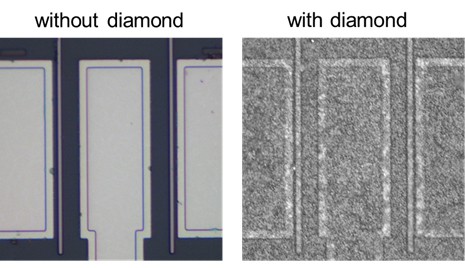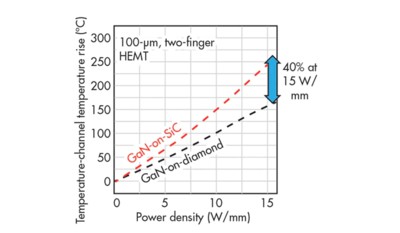New design reduces heat generation by 40 percent, enabling smaller radar systems
Fujitsu and Fujitsu Laboratories have successfully developed the world's first technology for growing a diamond film with highly-efficient heat dissipation on the surface of GaN HEMTs.
The new design reduces the amount of heat generated by the devices during operation by 40 percent, leading to simplification of the cooling system and making it possible to miniaturise radar systems that rely on GaN HEMTs. This improvement to the design will make it significantly easier to install larger numbers of the devices for applications including improved weather forecasing and 5G communications, says Fujitsu.
Fujitsu aims to commercialise its new high-heat-dissipation GaN HEMT amplifiers in 2022 for use in weather radar systems and next-generation wireless communication systems. The details of the technology and related research were presented at the International Conference on Materials Science '2019 MRS FALL MEETING & EXHIBIT' in Boston, USA.
Development Background
Transistors used in radar systems have higher output power due to the need to operate at longer distances, which increases the amount of heat they generate. This means they need to be cooled otherwise the performance degrades due to overheating. Cooling is expensive, takes up space which means the system is much bigger than ideal for many applications.
One way to reduce the size and complexity of the cooling system is to increase heat dissipation efficiency by covering not only the back surface of the GaN HEMT but also the front surface with a diamond film. This diamond film, which possesses excellent heat dissipation properties, would effectively lower the internal temperature of the GaN HEMT. In order to achieve this effect, however, a diamond crystal with a large grain size is required to pass heat efficiently so that heat does not accumulate inside the diamond.
A high temperature of about 900degC is usually required to grow such a diamond film, which unfortunately destroys the GaN HEMT underlying the diamond growth. When a diamond film is grown at low temperature (~ 650degC) at which the GaN HEMT is not destroyed, the resulting reduction in thermal energy given to the methane gas used to create the diamond means that the growth of the diamond is incomplete. Using the low temperature method, it is only possible to grow microscopic diamond particles (or nanodiamonds) of several hundred nanometers or less.
Furthermore, each particle becomes an aggregate of crystals facing different directions, which inhibits efficient heat transfer between particles (Figure 1 above).
To address this challenge, Fujitsu has developed a technology for growing a highly heat-spreading diamond film at low temperatures (about 650degC) where transistors are not destroyed, and in a world-first, succeeded in demonstrating the operation of a GaN HEMT with a highly heat-spreading diamond film on its surface.
To grow the diamond film with this method, nano-diamond particles with a diameter of several nanometers are placed on the entire surface of the device. The nano-diamond particles are then exposed to methane gas with high thermal energy to convert the carbon contained in the methane gas into diamond, which can then be incorporated into the particles. Carbon, with its high energy, is selectively incorporated into diamonds that point in a particular direction, allowing diamonds that point in the same direction to bond together and grow.

Focusing on the fact that the thermal energy given to methane varies depending on the pressure and the concentration of methane gas during diamond growth, Fujitsu discovered that nanodiamond particles oriented in a specific direction can be selectively enlarged at low temperatures. This makes it possible to convert a nanodiamond into a micrometer-sized diamond 1000 times larger (Figure 2 above). As a result, heat can easily pass through the diamond and the GaN HEMT can dissipate heat efficiently.
Outcome
By using the newly developed technology, the amount of heat generated during GaN HEMT operation is reduced by approximately 40 percent compared to without diamond film, and the temperature can be lowered by 100degC or more.

Fig. 3 Heat-spreading method and heat dissipation efficiency
Furthermore, by combining the heat dissipation from the back side of the GaN HEMTs with single-crystal diamond developed by Fujitsu and SiC bonding technology at room temperature, the front and back sides of the GaN HEMTs can be covered with a diamond film, which is expected to reduce heat generation by approximately 77 percent (Figure 3 abpve). This enables the use of small cooling devices for high-performance radar systems that previously required large cooling devices, thereby saving space and making it easier to install the large number of units demanded for advanced weather forecasing and communications technologies.
We focus on the research and development and production of diamonds, and have been technologically precipitated for more than ten years. Currently, diamond heat sinks, wafer-level diamonds, diamond metallization, diamond coatings (GaN), etc. Regarding heat dissipation solutions for high-power devices, we provide a comprehensive solution for new diamond heat dissipation materials.
 闽ICP备2021005558号-1
闽ICP备2021005558号-1Leave A Message